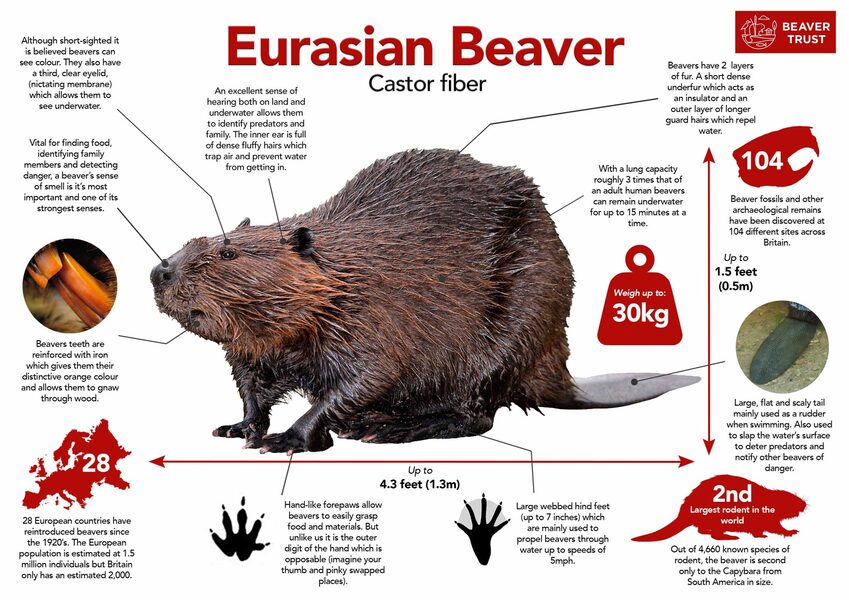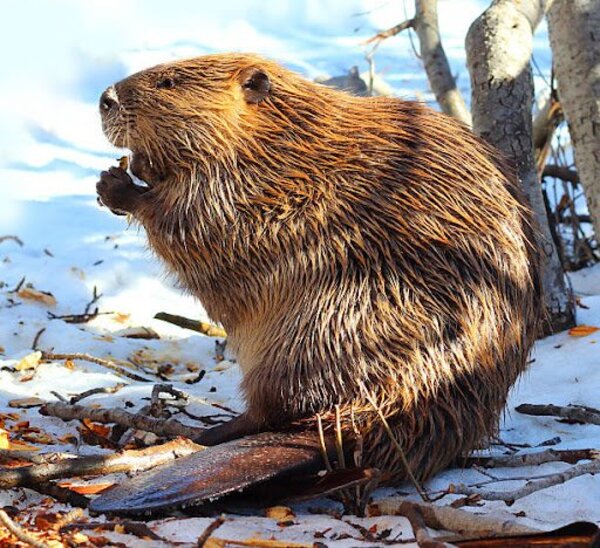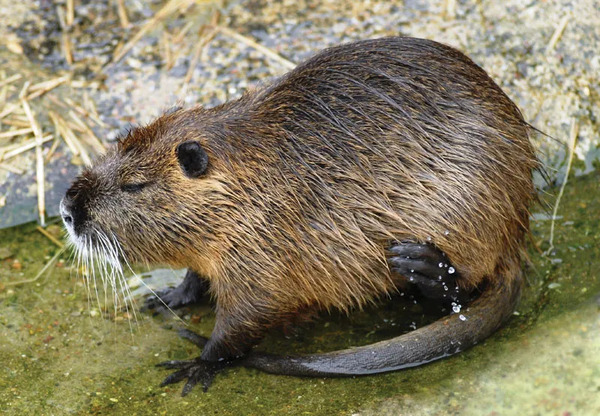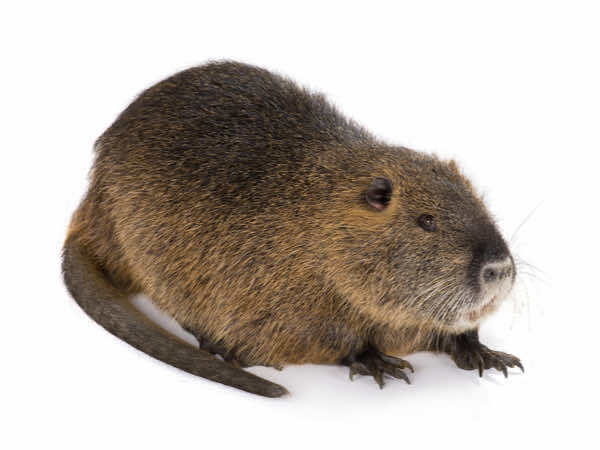When we think about animals that resemble beavers, the first creature that usually comes to mind is the beaver itself. Known for their flat tails and remarkable dam-building skills, beavers are fascinating creatures. However, there are several other animals that share similar traits or behaviors. In this article, we’ll explore these beaver-like animals, their habitats, behaviors, and interesting facts.
Beavers are remarkable creatures that play a crucial role in their ecosystems. Known for their exceptional building skills and ability to create wetlands, beavers have a fascinating biology that contributes to their success as a species. In this article, we will delve into the key aspects of beaver biology, including their anatomy, behavior, diet, reproduction, and ecological impact.
Beavers are the largest rodents in North America, with adults typically weighing between 40 to 60 pounds (18 to 27 kilograms). They can grow up to 3.5 feet (1 meter) long, including their flat, paddle-shaped tails, which can measure up to 12 inches (30 cm). Beavers have thick, waterproof fur that helps keep them warm in cold water, and their webbed feet make them excellent swimmers.
Beavers possess several adaptations that aid in their semi-aquatic lifestyle:
Teeth: Beavers have large, chisel-like incisors that continuously grow throughout their lives. These teeth are essential for gnawing on wood and other plant materials.
Tail: Their broad, flat tails serve multiple purposes: they help with swimming, act as a rudder, and provide balance while standing upright. Beavers also use their tails to slap the water's surface as a warning signal to other beavers.

Beavers are well-known for their ability to build dams, which create ponds and wetlands that provide essential habitat for many other species. They typically construct their dams using branches, mud, and other natural materials. These structures can vary in size, with some beaver dams measuring over 1,600 feet (500 meters) in length.
Beavers are social animals that typically live in family groups, called colonies. A colony usually consists of a breeding pair, their kits (young beavers), and sometimes yearlings from previous litters. They work together to maintain their dam and lodge, sharing responsibilities such as foraging for food and defending their territory.
Beavers are herbivores, primarily feeding on the bark, leaves, and twigs of trees and shrubs. Some of their favorite food sources include:
Willow
Aspen
Cottonwood
Alder
Beavers are known to store food underwater in preparation for winter, allowing them easy access to their food supply when the surface is frozen.
Beavers are monogamous, typically forming long-term pair bonds. The breeding season occurs in late winter, and after a gestation period of about 105 days, the female gives birth to a litter of 1 to 6 kits in the spring. The kits are born with their eyes open and can swim within hours of birth. They usually remain with their parents for one to two years, learning essential survival skills before establishing their territories.
In the wild, beavers can live up to 10 to 12 years, although they often face threats from predators and human activities that can shorten their lifespan.
Beavers are often referred to as "ecosystem engineers" due to their significant influence on their habitats. The ponds they create through dam-building provide critical wetland ecosystems that support diverse plant and animal species. These wetlands help improve water quality, reduce flooding, and recharge groundwater supplies.
The habitats created by beavers benefit many other species, including:
By creating wetlands, beavers promote biodiversity and contribute to the health of ecosystems.
Beavers are incredible animals with unique adaptations and behaviors that allow them to thrive in various environments. Their dam-building activities have far-reaching ecological impacts, enhancing biodiversity and contributing to healthy ecosystems. Understanding beaver biology is essential for appreciating the vital role they play in nature and the importance of conserving their habitats.

Beaver-like animals are typically rodents or semi-aquatic mammals that exhibit characteristics similar to beavers, such as a love for water, strong teeth for gnawing on wood, and, in some cases, a social structure that involves teamwork. Here are some animals that fit this description:
Capybaras are the largest rodents in the world, native to South America. These gentle giants are often found near water bodies like rivers, lakes, and wetlands. They have a similar social structure to beavers, living in groups that can consist of 10 to 20 individuals. Capybaras are herbivores, primarily eating grasses and aquatic plants. Their webbed feet make them excellent swimmers, and they can stay submerged for several minutes to evade predators.
Fun Fact: Capybaras have a unique ability to bond with various animal species, often seen lounging with birds, monkeys, and even domestic pets!
Capybaras are fascinating creatures and the largest rodents in the world. Native to South America, these gentle giants are well-adapted to their environments and exhibit unique behaviors and social structures. In this article, we will explore the biology, habitat, diet, social life, and ecological importance of capybaras.
Capybaras can weigh between 77 to 150 pounds (35 to 68 kg) and can grow up to 4 feet (1.2 meters) in length. They have a stocky body, short legs, and a large head with a blunt snout. Their fur is coarse and short, typically brown or reddish-brown, which helps them blend into their natural surroundings.
Capybaras are well-adapted for a semi-aquatic lifestyle:
Webbed Feet: Their partially webbed feet make them excellent swimmers, allowing them to move efficiently through water.
Buoyant Bodies: Capybaras can float due to their lightweight bones and fat composition, making it easy for them to navigate rivers and lakes.
Capybaras are primarily found in various habitats across South America, including:
Wetlands: They thrive in areas with abundant water sources, such as rivers, lakes, and marshes.
Grasslands: Capybaras often inhabit grasslands and savannas where they can find plenty of vegetation.
These habitats provide them with food and shelter from predators.
Capybaras are herbivores, primarily feeding on grasses, aquatic plants, and fruit. Their diet consists of:
Grasses: They graze on a variety of grasses, which make up the bulk of their diet.
Aquatic Vegetation: Capybaras often forage on water lilies and other aquatic plants found in their habitats.
Fruits and Vegetables: Occasionally, they will eat fruits and vegetables when available.
Capybaras are known for their unique chewing behavior, which involves re-ingesting their own feces to extract maximum nutrients from their food—a process known as coprophagy.
Capybaras are highly social animals that live in groups ranging from 10 to 20 individuals. Their social structure is complex, and they exhibit several interesting behaviors:
Hierarchy: Within a group, capybaras establish a social hierarchy, with dominant individuals often having priority access to food and mating opportunities.
Communication: Capybaras communicate through a variety of vocalizations, including barks, whistles, and grunts, which help maintain group cohesion and alert others to potential dangers.
Grooming: Social grooming is a common behavior, helping to strengthen bonds among group members.
Capybaras are seasonal breeders, typically mating during the rainy season. After a gestation period of about 150 days, females give birth to a litter of 2 to 8 pups. The young are precocial, meaning they are born relatively mature and can walk and swim shortly after birth.
In the wild, capybaras have a lifespan of around 8 to 10 years, while those in captivity can live up to 12 years or more due to reduced predation and access to veterinary care.
Capybaras play a vital role in their ecosystems:
Grazers: By consuming large quantities of vegetation, they help maintain the health of their habitats and prevent overgrowth.
Prey Species: Capybaras serve as a food source for various predators, including jaguars, caimans, and large birds of prey.
Seed Dispersers: As they feed on fruits and plants, capybaras contribute to seed dispersal, promoting plant diversity in their ecosystems.
Capybaras are unique and gentle animals that play an essential role in their habitats. Their social behaviors, adaptability, and ecological importance make them a fascinating subject of study. Understanding capybaras can help raise awareness about the need for conservation efforts to protect their natural environments and ensure their survival for future generations. Whether seen in the wild or in a zoo, capybaras are truly remarkable creatures that capture the hearts of many.

Nutria, also known as coypu, are large, semi-aquatic rodents native to South America but have spread to North America, Europe, and Asia. They resemble beavers with their thick bodies, webbed feet, and long tails. Nutria are known for their burrowing habits and can create extensive burrow systems near water sources. Unlike beavers, nutria primarily feed on aquatic plants and can be quite destructive to wetlands.
Interesting Fact: Nutria can reproduce rapidly, with females giving birth to up to 13 pups in a single litter!
Nutria, also known as coypu, are large semi-aquatic rodents native to South America. They have become established in various parts of the world, including North America, Europe, and Asia. Known for their distinctive appearance and adaptability, nutria play a unique role in their ecosystems. In this article, we will explore the biology, habitat, diet, social behavior, reproduction, and ecological impact of nutria.
Nutria are sizable rodents, typically weighing between 10 to 20 pounds (4.5 to 9 kg) and measuring about 2 to 2.5 feet (0.6 to 0.76 meters) in length, excluding their long, round tails. They have thick, coarse fur that is usually brown or grayish in color, with a lighter underside. Their large front teeth are adapted for gnawing, and their webbed hind feet make them excellent swimmers.
Nutria have several adaptations that help them thrive in their aquatic habitats:
Webbed Feet: Their hind feet are partially webbed, enabling them to swim efficiently and maneuver through water.
Buoyant Bodies: Nutria have a dense, heavy body that aids in buoyancy, allowing them to float easily while foraging for food.
Nutria are primarily found in wetlands, marshes, and riverbanks across South America, where they are native. They have been introduced to other regions, including parts of the United States, where they inhabit:
Wetlands: Nutria thrive in areas with abundant water sources, such as lakes, rivers, and swamps.
Coastal Areas: They are often found in coastal marshes and estuaries, where they can access both freshwater and brackish environments.
Nutria are herbivores, primarily feeding on a variety of aquatic and terrestrial plants. Their diet consists of:
Aquatic Plants: Nutria enjoy consuming water lilies, cattails, and other vegetation found in wetland areas.
Grasses and Grains: They also graze on grasses, sedges, and agricultural crops when available.
Nutria are known for their unique foraging behavior, often using their sharp teeth to gnaw on roots and stems of plants.
Nutria are social animals that often live in groups, known as colonies. These colonies can range in size from a few individuals to over a dozen. Their social behaviors include:
Hierarchy: Within a colony, there is often a social hierarchy, with dominant individuals having preferential access to food and mates.
Communication: Nutria communicate through a series of vocalizations, including whistles and growls, which help maintain group cohesion and alert others to potential dangers.
Grooming: Social grooming is common among nutria, helping to strengthen bonds within the group.
Nutria are prolific breeders, typically mating year-round in favorable conditions. After a gestation period of about 130 days, females give birth to litters of 1 to 13 kits. The young are precocial and can swim shortly after birth, allowing them to quickly join the group.
In the wild, nutria typically live about 3 to 5 years, although they can live longer in captivity due to reduced predation and access to veterinary care.
Nutria have a significant impact on their ecosystems, both positive and negative:
Vegetation Control: By feeding on aquatic and wetland plants, nutria help control vegetation growth, but overpopulation can lead to habitat degradation.
Prey Species: Nutria serve as a food source for various predators, including alligators, birds of prey, and larger mammals.
Ecosystem Alteration: Their burrowing behavior can impact soil structure and water flow, potentially affecting other species in the ecosystem.
Nutria are intriguing semi-aquatic rodents with unique adaptations that allow them to thrive in wetland environments. Their social behaviors, dietary habits, and ecological impact make them a significant species within their ecosystems. Understanding nutria can help inform management strategies, especially in regions where they have been introduced, ensuring that their presence contributes positively to local biodiversity. Whether admired in their native habitats or studied in a controlled environment, nutria continue to captivate those who encounter them.

Muskrats are smaller than beavers but share a similar lifestyle. They are found in North America and are known for their strong swimming abilities and burrowing habits. Muskrats build lodges made of reeds and mud, often in marshy areas or along riverbanks. They primarily feed on aquatic vegetation and are often active at dusk and dawn.
Did You Know? Muskrats have a distinctive flattened tail that helps them swim efficiently through water.
Muskrats (Ondatra zibethicus) are medium-sized semi-aquatic rodents native to North America. Known for their adaptability and distinctive features, muskrats play a crucial role in their ecosystems. This article will delve into their physical characteristics, habitat, diet, social behavior, reproduction, and ecological significance.
Muskrats are typically 20 to 25 inches (50 to 64 cm) long, including their long, flattened tails, which account for about one-third of their total length. They usually weigh between 2 to 4 pounds (0.9 to 1.8 kg). Key features include:
Fur: Muskrats have dense, waterproof fur that is dark brown or grayish-brown on the back and lighter on the belly. This fur helps insulate them in cold water.
Webbed Feet: Their hind feet are partially webbed, which aids in swimming and maneuvering through aquatic environments.
Teeth: Muskrats possess large, sharp incisors that grow continuously, allowing them to gnaw on tough plant material.
Muskrats are well-adapted to their aquatic habitats:
Swimming Ability: Their streamlined bodies and webbed feet enable efficient swimming, making them excellent foragers in water.
Burrowing Skills: Muskrats construct burrows in banks or build lodges using reeds, cattails, and mud, providing shelter and protection from predators.
Muskrats are found across North America, thriving in a variety of wetland environments:
Wetlands: They inhabit marshes, swamps, ponds, and riverbanks, where they can access abundant food sources.
Adaptable Range: Muskrats can tolerate a range of habitats, including both freshwater and brackish waters, making them highly adaptable to different environments.
Muskrats are primarily herbivorous, feeding on a variety of aquatic and terrestrial plants. Their diet includes:
Aquatic Vegetation: They consume a range of plants, including cattails, water lilies, and sedges.
Terrestrial Plants: Muskrats will also forage for grasses, grains, and agricultural crops when near farmland.
Muskrats have a unique foraging behavior; they often dive underwater to gather food, using their front paws to grasp and manipulate plants.
Muskrats can be solitary or social, depending on the availability of resources and environmental conditions. Their social behaviors include:
Territoriality: Males are often territorial and will defend their feeding grounds from other muskrats.
Communal Living: In some areas, muskrats may live in small family groups or colonies, sharing burrows and foraging grounds.
Vocal Communication: They communicate using a variety of sounds, including chirps, whistles, and growls, which help maintain group cohesion and alert others to potential dangers.
Muskrats are seasonal breeders, typically mating in late winter to early spring. After a gestation period of about 30 days, females give birth to litters of 4 to 10 kits. The young are born blind and hairless but grow quickly, becoming independent within a few weeks.
In the wild, muskrats generally live around 3 to 5 years, although some may live longer in protected environments or in captivity.
Muskrats play a vital role in their ecosystems:
Vegetation Management: By consuming a variety of aquatic plants, muskrats help control plant growth, promoting biodiversity in wetland habitats.
Prey Species: They serve as a food source for numerous predators, including foxes, birds of prey, and larger mammals, contributing to the food web.
Habitat Modification: Their burrowing and feeding behaviors can create habitats for other species, influencing the structure and function of wetland ecosystems.
Muskrats are fascinating and adaptable rodents that thrive in diverse aquatic environments. Their physical characteristics, social behavior, and ecological roles highlight their importance in maintaining healthy ecosystems. Understanding muskrats can inform conservation efforts and management strategies, particularly in wetland areas. Whether encountered in the wild or studied in controlled settings, muskrats continue to captivate those who appreciate the complexity of nature.

Beaver-like animals typically thrive in wetland environments. They are often found in:
Rivers and Streams: Many of these animals build homes or lodges near flowing water, where they can find food and shelter.
Lakes and Ponds: Stagnant water bodies provide a rich source of aquatic plants for these animals.
Marshes and Wetlands: These areas are perfect for animals like nutria and muskrats, which rely on abundant vegetation.
Like beavers, many of these animals exhibit social behaviors. For example, capybaras live in large groups and have a hierarchical structure, while muskrats may form small family units. This social structure helps them protect against predators and find food more efficiently.
Many beaver-like animals face threats from habitat loss, hunting, and environmental changes. Conservation efforts are vital to ensure their survival. For example, protecting wetlands can help maintain healthy populations of capybaras and muskrats.
Beaver-like animals play essential roles in their ecosystems, much like beavers do. From capybaras and nutria to muskrats, these creatures share fascinating similarities with beavers, making them equally interesting. Understanding and protecting these animals can help maintain biodiversity and the health of our wetland environments. Whether you're a wildlife enthusiast or simply curious about nature, exploring the world of beaver-like animals can be a rewarding experience!
In the world of semi-aquatic rodents, beavers, capybaras, nutria, and muskrats each play distinct ecological roles and possess unique characteristics. This article provides a detailed comparison of these fascinating animals, highlighting their physical traits, habitats, diets, social behaviors, and ecological impacts.
| Feature | Beaver (Castor canadensis) | Capybara (Hydrochoerus hydrochaeris) | Nutria (Myocastor coypus) | Muskrat (Ondatra zibethicus) |
|---|---|---|---|---|
| Size | 35-60 inches (89-152 cm) | 39-51 inches (100-130 cm) | 20-25 inches (50-64 cm) | 20-25 inches (50-64 cm) |
| Weight | 35-100 lbs (16-45 kg) | 77-146 lbs (35-66 kg) | 10-20 lbs (4.5-9 kg) | 2-4 lbs (0.9-1.8 kg) |
| Fur Color | Brown, waterproof | Brown to reddish-brown | Brownish-gray | Dark brown to grayish-brown |
| Habitat | Freshwater lakes, rivers, ponds | Wetlands, grasslands, savannas | Marshes, riverbanks | Marshes, wetlands, ponds |
| Diet | Bark, leaves, aquatic plants | Grasses, aquatic plants, fruits | Aquatic plants, roots, crops | Aquatic plants, grasses |
| Social Structure | Social, lives in family groups | Social, lives in large groups | Social, lives in colonies | Can be solitary or social |
| Reproduction | 1-4 kits per litter, 1-2 litters/year | 2-8 pups per litter, 1-2 litters/year | 4-13 kits per litter, 1-2 litters/year | 4-10 kits per litter, 1-2 litters/year |
| Lifespan | 10-12 years in the wild | 8-12 years in the wild | 3-5 years in the wild | 3-5 years in the wild |
| Ecological Role | Dam builders, habitat creators | Grazers, seed dispersers | Vegetation control, prey for predators | Vegetation management, prey species |
Beavers are the largest rodents in North America, known for their robust bodies, flat tails, and webbed feet. Their fur is thick and waterproof, allowing them to thrive in aquatic environments.
Capybaras are the largest rodents in the world, characterized by their barrel-shaped bodies and webbed feet. Their fur is coarse and helps insulate them from water.
Nutria are smaller than beavers and capybaras but share similar adaptations for a semi-aquatic lifestyle, including webbed feet and dense fur.
Muskrats are the smallest of the four, with a streamlined body and long, scaly tails. Their fur also aids in swimming and insulation.
Beavers create and inhabit ponds by building dams, which significantly alter their ecosystems.
Capybaras prefer areas near water bodies, often found in grasslands and savannas where they can graze on abundant vegetation.
Nutria thrive in marshy areas and are often found near rivers and lakes, where they can easily access their preferred food sources.
Muskrats inhabit wetlands and marshes, often creating burrows in banks or constructing lodges.
Beavers primarily eat tree bark, leaves, and aquatic plants, using their strong teeth to fell trees for food and building materials.
Capybaras are herbivores that consume grasses, aquatic plants, and fruits, and are known for their grazing habits.
Nutria feed on various aquatic plants and can damage crops due to their foraging behavior.
Muskrats primarily eat aquatic vegetation, including roots and stems, and occasionally graze on terrestrial plants.
Beavers live in family units consisting of a breeding pair and their offspring, showcasing strong social bonds.
Capybaras are highly social animals that live in large groups, often consisting of 10-20 individuals, fostering cooperative behaviors.
Nutria form colonies and exhibit social interactions, often seen grooming one another.
Muskrats can be solitary or social, depending on environmental conditions and resource availability.
Beavers typically breed once or twice a year, with litters of 1-4 kits, which remain with their parents for up to two years.
Capybaras breed year-round, giving birth to 2-8 pups, which are precocial and can swim shortly after birth.
Nutria have a high reproductive rate, producing litters of 4-13 kits several times a year.
Muskrats have a similar reproductive strategy, giving birth to 4-10 kits, with multiple litters annually.
Beavers are known as "ecosystem engineers" due to their dam-building activities, which create wetlands that benefit numerous species.
Capybaras contribute to seed dispersal and help maintain the balance of grassland ecosystems through grazing.
Nutria can impact aquatic vegetation and compete with native species, but they also serve as prey for various predators.
Muskrats manage plant growth in wetlands and are important food sources for many predators.
Beavers, capybaras, nutria, and muskrats each have unique characteristics that enable them to thrive in semi-aquatic environments. Understanding their differences and similarities is essential for effective wildlife management and conservation efforts. Each species contributes to the ecosystem in its own way, highlighting the importance of biodiversity in maintaining healthy environments.
animal tags: Beavers capybaras nutria muskrat
We created this article in conjunction with AI technology, then made sure it was fact-checked and edited by a Animals Top editor.